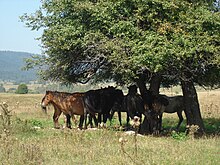Bosniak (horse)
| Bosniak | |
|---|---|

Bosnian mountain pony |
|
| Important data | |
| Origin: | Bosnia and Herzegovina |
| Main breeding area: | former Yugoslavia, Germany |
| Distribution: | former Yugoslavia, Germany |
| Stick measure : | 132-147 cm |
| Colors : | Dun, black, fox, bay, gray, Isabell |
| Main application area: | Säumer, agriculture, riding, load, draft horse |
The Bosniak (also Bosniak or Bosnian Mountain Horse ) is the typical, frugal mountain horse of the Dinarides . Bosniaks are distributed from Croatia via Bosnia and Herzegovina , Montenegro and Serbia to Macedonia . Until the 1960s they were the most important agricultural workhorses in the mountain regions of the Western Balkans and have been exported to Western Europe in various ways.
Background information on horse evaluation and breeding can be found under: Exterior , interior and horse breeding .
Exterior
The height of the Bosniak is between 130 and 148 cm. It comes in the colors dun, black, fox, bay and gray, white markings and gray are rare. The medium-weight head with a broad forehead, large, dark eyes and pronounced nostrils stands on a strong neck with a lush mane and a sloping shoulder and broad chest. The low withers is followed by a stocky torso with strong arching of the ribs and straight, short, strong back, which ends in a sloping croup with a deep tail and a thick tail. The sturdy, slightly cow-hocked legs stand on very hard little hooves.
interior
The Bosniak is considered robust and undemanding. As a typical mountain horse, he is persistent, sure-footed and has strong nerves. Thanks to their stamina, they are ideal for hiking and endurance riding.
Breeding history
The origin of these tough horses from the Dinarides probably goes back to the Tarpan . The Bosniak is a reliable and persistent pack animal on difficult mountain trails and the all-purpose horse of the Dinaric high builders. During the Turkish occupation of the Balkans from the 14th to 17th centuries, Arabs were often crossed. The robustness of the Bosniaks suffered and they became rather useless for the farmers. Therefore, in 1933, the original, strong type was bred again. The three stallions Barut , Misko and Aslan were used as main sires. The stallions and mares had to pass a performance test in order to be approved for breeding: they had to carry a load of 120 kg over a distance of 16 km. The best time was 71 minutes. It was bred in the Yugoslav state studs "Borike" and "Han Pijesak" in Sarajevo, Mostar and Goražde. In addition to the farmers, the military was particularly interested in these horses. After the Second World War, however, demand fell sharply due to increasing motorization. In the state stud "Borike" an attempt was made to set up a regular breed with first-class animals. Because of the Bosnian War , breeding there was broken. In the 20 years before that, however, over 3000 animals were imported to Germany. Two interest groups have emerged here that strive to preserve the breed. The population is threatened both in Germany and in the rest of Europe. In Germany, the breed is mainly cared for by the Rhenish Horse Studbook (5 stallions / various mares registered) and also by the special horse breed association in Bavaria.
literature
- Enver Ziga, Refik Telalbasic: The Bosnian Mountain Horse. A monography. Sahinpasic Publishing House, Sarajevo 2008, ISBN 978-9958-41-295-0 .
- Gertrud Grilz-Seger, Thomas Druml: The Bosnian mountain horse . Vehling Verlag, 2015, Graz, ISBN 978-3-85333-263-4 .
